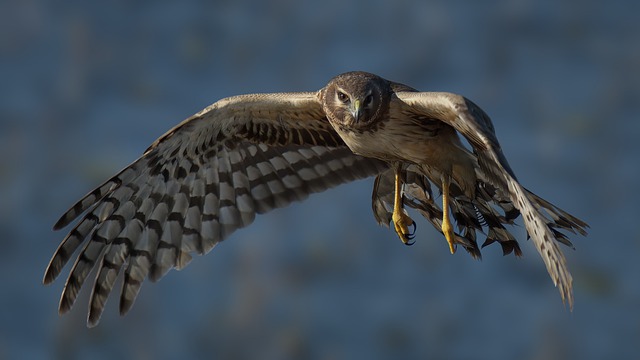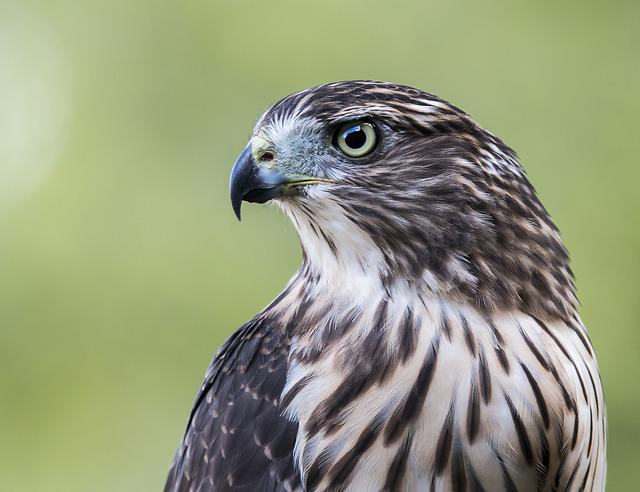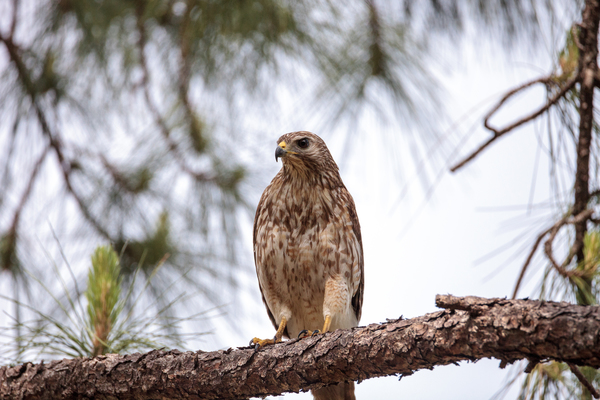Nestled in the heart of the Eastern United States, New Jersey is a state that’s teeming with wildlife, from black bears to bald eagles.
However, there’s one group of birds of prey that stands out in particular: Hawks.
With their sharp talons, keen eyesight, and an impressive wingspan, these majestic creatures are a common sight in the Garden State.
In fact, there are eight different types of hawks that call NJ home, each with its own unique features and behaviors.
Whether you’re an avid bird watcher or simply fascinated by these magnificent creatures, read on to discover the incredible world of New Jersey’s hawks.
| Image | Name |
|---|---|
 | Red-tailed Hawks |
 | Northern Goshawk |
 | Rough-legged Hawk |
 | Northern Harrier |
 | Cooper's Hawks |
 | Sharp-shinned Hawk |
 | Red-shouldered Hawks |
 | Broad-winged Hawks |
Types of Hawks in New Jersey (NJ)
1. Red-tailed Hawks

Across the continent, the red-tailed hawk is among the most frequent hawk.
These massive hawks winter over in New Jersey.
With their keen eyesight, Red-tailed Hawks are frequently spotted swooping through the sky in search of food or sitting on power lines by the side of the road.
The distinctive, raspy call of the Red-tailed Hawk is instantly recognizable as that of a raptor.
In addition, the shriek of a Red-tailed Hawk is the one most often utilized in films to represent the ferocity of these birds of prey.
2. Northern Goshawk

It’s true that you can see a Northern Goshawk anywhere throughout New Jersey; however, they spend the majority of the season in the state’s northern regions.
These huge hawks do not nest mostly in the remainder of the state; therefore, they make an annual migration through the region.
The Northern Goshawk is an accipiter with curved wings and a long tail, similar to the Sharp-shinned Hawk and the Cooper’s Hawk.
Northern Goshawks, on the other hand, are the biggest accipiters throughout North America and are significantly larger than any of the other accipiters found here.
The Northern Goshawk is a bird of mystery. Even if they remain the most common accipiter, spotting them may be challenging since they like to hide in huge, thick woods.
The Northern Goshawk is characterized by its mostly crimson eyes, gray feathers, and white lines that give it the impression of eyebrows.
Many see them as emblems of power; Attila the Hun even got one painted on his forehead.
Falconers have been using Northern Goshawks for hunting for almost 2,000 years.
Historically, these hawks earned the name “cooks hawks” due to their skill in bringing in fresh meat for meals.
3. Rough-legged Hawk

The whole state of New Jersey is considered to be inside the non-breeding habitat of the Rough-legged Hawk.
They spend most of the year on the wide Arctic tundra, which is also the place they reproduce.
Nonetheless, in the autumn, they make the long journey south, spending the winter throughout most of southern Canada and the United States.
You may find them across New Jersey throughout the wintertime; however, they are more elusive than other species.
The availability of lemmings, a primary food source, throughout the Arctic has a significant impact on the population of these animals, which varies widely from year to year.
The rough-legged hawk’s feathery legs are an adaptation for life in the Arctic.
Both these hawks and the Golden Eagle are the sole American raptors to have plumage on their legs and feet all the down to their claws.
Buteo hawks of the species Rough-legged are the largest of the hawks, with stout frames and big, wide wings.
The feet and beaks of these birds are tiny, but they have longer tails than other buteos.
During flying, their tails spread out, and their wings are held in a “V.” position.
North American birds come in a wide range of feather colors, from black to white.
Males of the light variant are gray-brown on top and white below as adults, whereas males of the dark variant appear brown on top and white underneath.
4. Northern Harrier

Only one species of harrier hawk, the Northern Harrier, is native to North America.
Several populations spend the winter months in warmer climes farther south, while others’ breeding grounds extend as far north as Canada.
The United States is home to a variety of hawk species, and in certain regions, these birds remain year-round.
You may see Northern Harriers all through the year in the Garden State.
Northern Harriers, like owls, use both sight and sound for hunting, and they may use water to sedate their bigger prey.
While it’s very uncommon for men to have only one or two female companions at a time, they’re allowed to have up to five.
If you’re looking for one of these hawks, you’ll have the most luck finding it in a field or a marsh.
New Jersey is home to a variety of hawks, but the Northern Harrier is the most owl-like.
When hunting, they depend significantly on both their eyesight and hearing.
5. Cooper’s Hawks

Cooper’s are bigger than Sharpies, although both species have brilliant blue backs and wings with a scarlet banding on the stomach.
Female hawks are bigger than males; therefore, it’s not surprising to see size differences between giant female sharpies and little male Coopers.
Cooper’s Hawks may be distinguished from other hawks thanks to their broader heads and rounder tails.
Cooper’s hawks are among the best when it comes to flying.
They are strong predators because of their speed, strength, stealth, and agility; they are able to pierce the canopy to pursue their victims.
Cooper’s hawks are common, so don’t be alarmed if one swoops down on your garden feeders.
Tiny birds in the open, intent on filling their beaks? We’re basically handing the hawks their food.
While they may eat smaller birds if necessary, jays, starlings, chickens, doves, robins, grouse, and quail are their preferred prey.
A hawk’s ruthlessness is well-known. Cooper’s hawks, like other hawks, kill their victim by compressing it to death, although some birds have been spotted going so far as to drown their victims.
6. Sharp-shinned Hawk

In North America, the Sharp-shinned Hawk seems to be the tiniest hawk species.
You may find them all across Canada and the United States, even in New Jersey.
However, you can only see them in certain sections of the state all year long.
Their white bellies are barred with copper, and their blue-grey napes, crowns, and backs provide a hooded appearance.
It’s easy to see the crimson color in their eyes.
It’s common knowledge that sharpies frequent garden bird feeders.
If you observe a hawk, it may be best to remove your feeders for a week or two to give it space to move on.
The Sharpie’s diet consists almost entirely of songbirds.
Due to this, they are able to fulfill their crucial role in maintaining sustainable and controllable populations of wild bird species.
7. Red-shouldered Hawk

Red-shouldered Hawks, which are closely related to Cooper’s Hawks and have a similar range, are found solely across New Jersey during the whole year.
These hawks have dark, rich chestnut plumage that seems mottled on the wings and are marked by bands on the chest.
Both their tail and eyes are completely black.
Wet coniferous forests are ideal habitats for red-shouldered hawks.
If you happen to be walking around and see this bird, chances are you’re not far from a body of water like a river, wetland, or marsh.
Red-shoulders, in contrast to certain other bird-eating species, would rather consume something that doesn’t have feathers if they had the choice.
Their diet consists mostly of reptiles and amphibians, with a smattering of small mammals.
Young red-shouldered hawks are a common target for Great Horned Owls.
It is not uncommon for crows and hawks, both of which the owl preys upon, to group together and drive away Great Horned Owls in large groups.
8. Broad-winged Hawk

“The Broad-winged You can only find Hawks in the summer and spring across New Jersey and the remainder of New England, where they come to mate.
Broad-winged Hawks travel in big groups, or “kettles,” of several thousand every year during their annual migration.
There is just one brood of 1 to 5 eggs laid by a broad-winged hawk per year.
Nest building is mostly the female’s responsibility; however, the male will pitch in where he can.
They are quite protective of their nesting territory, therefore, they put it at least half a mile away from any other raptor nests.
Like other raptors, its food consists mostly of meat and other large, prey-like animals.
Conclusion
In conclusion, New Jersey is truly a paradise for hawk enthusiasts, with its diverse range of habitats and abundance of prey attracting many different species of hawks.
From the diminutive sharp-shinned hawk to the powerful red-tailed hawk, each of the eight species that call NJ home has its own distinctive characteristics and behaviors.
Whether you’re lucky enough to spot one soaring through the sky or simply enjoy learning about these incredible birds of prey, NJ’s hawks are sure to captivate and inspire.
So get out there, keep your eyes peeled, and see if you can spot all eight of these magnificent creatures in action.
FAQ
When is the best time to see hawks in New Jersey?
The best time to see hawks in New Jersey is during their migration period, which typically occurs from late August to early December. During this time, hawks can be seen in large numbers as they travel south for the winter.
Where are the best places to see hawks in New Jersey?
Some of the best places to see hawks in New Jersey include High Point State Park, Cape May Point State Park, and Hawk Rise Sanctuary. These areas offer open fields and clear views of the sky, which are ideal for spotting hawks as they soar overhead.
How can I identify the different types of hawks in New Jersey?
The different types of hawks in New Jersey can be identified by their size, shape, and markings. For example, the sharp-shinned hawk is a small hawk with a rounded head and short wings, while the red-tailed hawk is a larger hawk with broad, flat wings and a distinct red tail.
Are hawks dangerous to humans?
Hawks are generally not dangerous to humans, and attacks on humans are extremely rare. However, it’s important to avoid disturbing hawks or their nests, as they may become aggressive if they feel threatened.
What do hawks eat?
Hawks are carnivores and primarily feed on small mammals, such as mice, rabbits, and squirrels. They may also eat birds, reptiles, and insects, depending on their species and location.
Are hawks protected in New Jersey?
Yes, hawks are protected under the Migratory Bird Treaty Act, which makes it illegal to harm or disturb them or their nests. It’s important to observe hawks from a distance and avoid disturbing them or their habitat.
Last Updated on March 22, 2023 by Lily Aldrin
